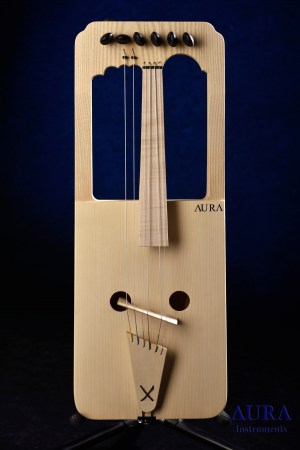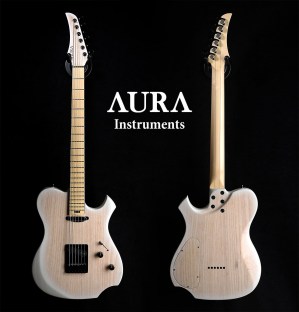Kravik Lyre Aura 7 ProKL
Detailed description and composition of this tool can be found in the text below, below the photo:

Innovative modern look of historical musical instruments on AuraInstruments.
Kravik lyre Aura 7 ProKL is a handmade medieval string instrument that we offer you in an innovative modern form.
Used components for Kravik lyre Aura 7 ProKL:
- Body: Maple.
- Top: Ovangol.
- Tuning: C D E F G A B.
- Strings: Nylon.
- Finish: Saten Nitro Lacquer.
- Grasshopper, Bridge: Maple.
- Number of strings: 7.
History and Origin of Kravik lyre:
Origin of Kravik Lyre.
Kravik lyre is a Lyre of Scandinavian origin - from Norway. That is why it is often called The Norwegian Kravik Lyre.
Its present appearance and name is probably based on an instrument known as the archaeological find "Kravik Lyre". It was an "archaeological find" found on a Norwegian farm in the Numedal Valley. The tool has been preserved thanks to the fact that the owners carried it from generation to generation as a precious treasure.
Thanks to this, later exact replicas of the preserved lyre could be created.
Which year does Kravik lyre come from?
It has long been assumed that this musical instrument comes from Norway from the 14th century. However, scientific tests - based on carbon - have found that it most likely dates back to the 16th century.
Late continuation of the striking lyre in Europe.
Even if it dates back to the 16th century, Kravik lyre still represents the late continuation of the striking lyres in Northern Europe - probably marks the beginning of the end of an era of such striking lyres, which have gradually replaced more string harps and various string instruments.
Composition of the original Kravik Lyre.
The original Kravik lyre was made and carved from a piece of pine wood, and many parts, including the sound board and baffle, were unfortunately not preserved.
Reborn of the original Kravik Lyre.
Although the bridge was not preserved on the original instrument, bridges found in other areas of Norway helped to re-establish the original Kravik Lyre. So these bridges were used as the basis for the bridge to renovate Kravik Lyre.
Some of today's Kravik Lyrs are made with eight strings - and with eight holes in the lyre body - the original Kravik lyre had seven strings - and seven holes in the lyre body.
The popularization of Kravik Lyre nowadays.
The credit for the popularization of Kravik Lyre is the Norwegian musical instrument maker Sverre Heimdal, who was the first to produce a replica of the original Kravik Lyre and has made a major contribution to the popularization of this atypical musical instrument.
Positioning String Pins - Front or Back?
Today's producers Kravik Lýr argue how the strings were originally placed - whether they were placed from the back or front of the instrument. Some place them in the front, others in the back - or leave it to the customer's choice.
Sverre Heimdal popularizer of today's Kravik Lyre:
Sverre Heimdal was the first manufacturer to produce Kravik lyre with strings placed at the back of the instrument. And the other manufacturers were inspired by it. So, it can make it difficult to determine what pin placement the original lyres had.
Famous manufacturer of medieval instrument - Michael King:
Another well-known world manufacturer of medieval musical instruments, Michael King, believes that strings have been placed on the back - this is mainly due to the fact that fitting the strings at the back works well and provides a larger break angle. And according to him, this is also likely because other lyres - for example, lyre Jouhikos were produced in this way.
In any case, the makers of these instruments and their fans agree that the sound does not affect the location of the strings. Rather, it is mainly an aesthetic function.
What is lyre:
lyre is one of the first string instruments. It consists of a wooden body (originally supposedly used for the production of body shell of turtles), a sound box connected to the partition and two arms. It usually contains seven pins and seven strings.
The oldest lyres were confirmed already in ancient Mesopotamia but also in ancient Egypt, Greece and Rome.

 English (United Kingdom)
English (United Kingdom)  Slovenčina (Slovak)
Slovenčina (Slovak)  Čeština
Čeština 















